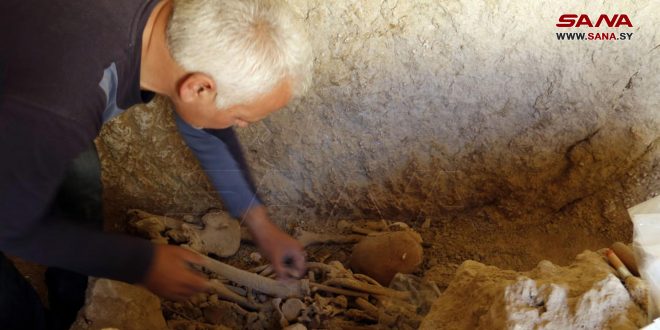An important Roman archaeological burial was recently discovered on a street in the city of Masyaf.This confirms the Roman presence in the city which, the archaeologists believe, was founded in its current form during that era.
Engineer Hazem Georges, Director of Hama Antiquities, explained to SANA that the Masyaf City Council discovered the cemetery during the construction of a road in the city where they found a Roman burial in a rock block.
According to Georges, the burial contains a door on the southeast side that is closed with stones, in addition to a number of skeletons, temples, and worn-out wooden coffins, of which only nails remain. There are also 20 pottery finds that were used during the burial of each dead person as an expression of grief, in addition to metal bracelets, glass beads, pottery ashes, pottery and glass fragments, which are being studied by archaeologists and experts in Hama and Masyaf to determine the burial’s association with Roman settlement in Masyaf City.
 Head of the Masyaf Antiquities Department, Eng. Asmahan Jabr Al-Wazeh, suggested that the archaeological burial dates back to the late Hellenistic era and the beginning of the Roman era, pointing out that it contains some ornaments, showing that a number of the skeletons belong to women.
Head of the Masyaf Antiquities Department, Eng. Asmahan Jabr Al-Wazeh, suggested that the archaeological burial dates back to the late Hellenistic era and the beginning of the Roman era, pointing out that it contains some ornaments, showing that a number of the skeletons belong to women.
Asmahan asserted that the discovery of the tomb and studying it thoroughly and accurately enriched archaeological research on the Masyaf region, which is believed to contain many archaeological tombs that were removed due to urban development and the lack of archaeological knowledge and experience.
“An archaeological survey should be carried out in the area to redraft and determine the history of the city of Masyaf and its cultural link to neighboring archaeological sites,” she added.
Archaeological researcher Rakan Suleiman stated that the existence of the tomb within a water-resistant rocky mass helped to protect the skeletons from disintegration, pointing out that studies will be conducted during the coming period to reveal more details and secrets of the tomb.
Amal Farhat

